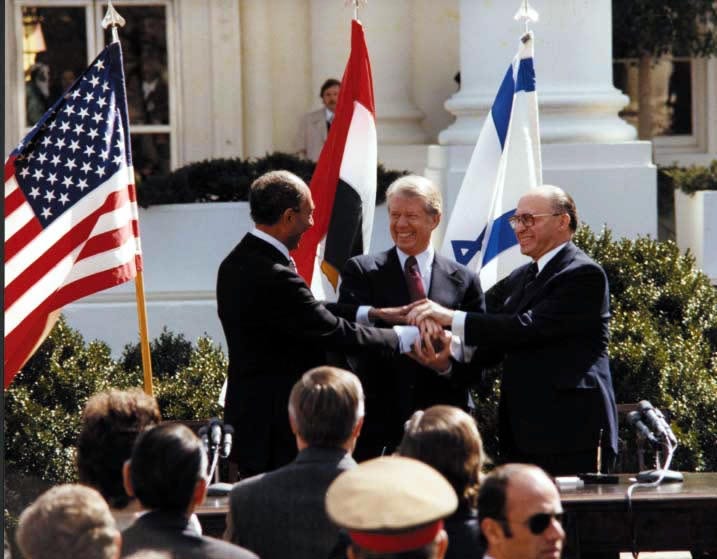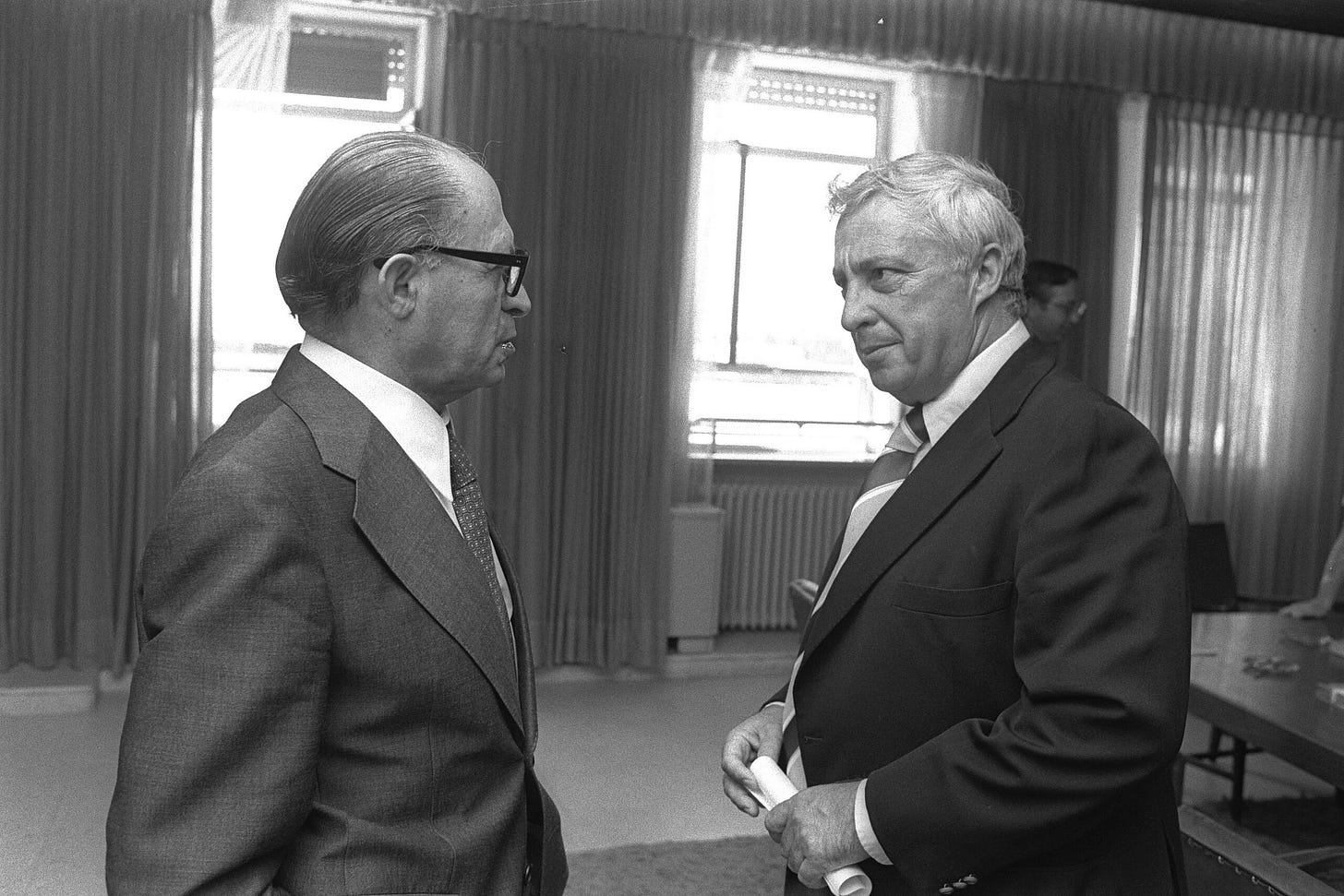Antisemitism is the reason Zionism exists.
Like all domino effects, the results have been a mix of tragedy, resilience, and unexpected opportunity.
Please consider supporting our mission to help everyone better understand and become smarter about the Jewish world. A gift of any amount helps keep our platform free of advertising and accessible to all.
You can also listen to the podcast version of this essay on Apple Podcasts, YouTube Music, YouTube, and Spotify.
History is not a static timeline of dates and events. It is a living organism — one decision, one action, one chance occurrence bumping into the next, each setting off ripples that stretch across years, continents, and generations.
Sometimes the chain is obvious, like watching a neat row of dominoes fall. Other times, the connection between cause and effect is subtle, hidden under layers of politics, culture, and memory.
For Jews and for Israel, this chain-reaction nature of history is not an abstract idea; it’s the air we breathe. Our story is full of moments where the choice or misstep of one era reshaped the next — from ancient exile birthing the Talmud, to modern wars that rewrote the political map.
And like all domino effects, the results have been a mix of tragedy, resilience, and unexpected opportunity.
The early Zionist movement itself, dating back to the 1800s, was fueled by the relentless dominoes of Jewish persecution — pogroms in Eastern Europe, expulsions from Western Europe, and legal restrictions across the diaspora — which convinced leaders like Theodor Herzl that sovereignty was the only safeguard for the Jewish future.
(Side note: Herzl was a secular, assimilated Viennese journalist who believed Jews could thrive in Europe — until he covered the antisemitic show trial of Alfred Dreyfus in France. The humiliation and injustice he witnessed convinced him that Jewish safety required sovereignty, catalyzing the political Zionist movement.)
In the late Ottoman era, much of the land in what was then called “Palestine” was owned not by local peasants, but by absentee landlords — wealthy Arab and Ottoman elites living in Beirut, Damascus, and Istanbul. When Jewish pioneers began arriving in the late 19th and early 20th centuries, many of these landlords, eager for profit, sold large tracts to Jewish organizations. The sales were legal and often at above-market prices, but the result was that Arab tenant farmers, who had no formal ownership rights, were sometimes evicted or displaced.
This created a potent source of resentment. Local Arab peasants, who would later be rebranded in the 20th century as “Palestinians,” began to see Jewish immigration not as a neighborly coexistence, but as a threat to their livelihoods. That resentment was stoked by local leaders and nationalist agitators, some of whom saw in it an opportunity to rally political opposition.
What began as a series of private land transactions under the Ottoman legal system became one of the early sparks of the Arab-Jewish conflict, a domino whose effects would echo into the British Mandate period, the 1948 war, and the modern debate over land and sovereignty.
In the 1920s, following the Ottoman Empire’s collapse in World War I, Jewish pioneers in British-era Palestine undertook massive efforts to drain swamps and eradicate malaria, particularly in areas like the Jezreel Valley and Hula region. These projects transformed previously uninhabitable land into fertile farmland, while Jewish agricultural settlements and urban development created new economic opportunities.
The improved living conditions and growing job market attracted a surge of Arab migration from surrounding regions — Syria, Lebanon, and Transjordan — drawn by the prospect of work in Jewish-founded enterprises. Ironically, the very development work intended to secure a Jewish foothold in the land also swelled the local Arab population, planting demographic and political seeds that would later factor into the intensifying conflict.
Then came Nazi Germany’s genocide of European Jewry, which not only wiped out centuries-old communities, but also accelerated international consensus on the need for a modern Jewish homeland. The horrors of the Holocaust tipped the moral and political balance toward the 1947 United Nations partition vote, creating the modern State of Israel.
In another striking example of history’s chain reactions, the Soviet Union was among the first nations to support the creation of the State of Israel in 1948, even providing crucial backing for the UN Partition Plan and allowing Czechoslovakia to supply arms that proved vital in Israel’s War of Independence.
At the time, Moscow saw Israel as a potential socialist ally in the Middle East. But as Israel aligned itself with the Western bloc during the Cold War, the USSR pivoted dramatically. In the 1950s and 1960s, the Soviets began courting the Arab states, supplying them with arms, training, and diplomatic backing.
This shift wasn’t only about geopolitics; it helped reframe the Arab-Israeli conflict itself. The USSR amplified and exported the narrative of the Arab refugees from 1948, promoting the term “Palestinians” as a distinct national identity in global diplomacy and media. This ideological and linguistic rebranding was part of a broader Soviet strategy to position Israel as a “Western colonial outpost” and the Palestinians as an “anti-imperialist” cause.
The Soviet turn didn’t just redraw alliances; it redefined the conflict, ensuring that the Palestinian question became a permanent fixture in Middle East politics for decades to come.
In 1973, Israel was caught off guard by a coordinated Arab attack, known today as the Yom Kippur War. The shock to national security doctrine was profound, but it also jolted both Israel and Egypt into a different strategic reality. Within a few years, Egyptian President Anwar Sadat would come to Jerusalem, and the first Arab-Israeli peace treaty was signed. A bloody war domino led, unexpectedly, to peace.

Then came the 1973 oil crisis, triggered in part by the Arab states’ retaliation for Western support of Israel during the Yom Kippur War, sending shockwaves far beyond the Middle East. By imposing an oil embargo, OPEC weaponized energy on a scale the world had never seen, quadrupling prices almost overnight.
For the first time, Western nations felt their economies hostage to Middle Eastern politics, and the experience permanently altered their foreign policy calculus. Energy security became a central plank of national security, prompting major investments in alternative energy and new exploration.
Diplomatically, Europe in particular sought to placate Arab oil producers, often by taking more critical positions on Israel in international forums. The embargo also forced the United States and the Soviet Union to recalibrate their regional strategies, understanding that alliances in the Middle East now carried direct economic consequences.
The 1973 oil embargo didn’t just send shockwaves through Western economies; it transformed Saudi Arabia into a regional superpower almost overnight. As oil prices quadrupled, the kingdom’s coffers exploded with petrodollars, giving it unprecedented financial and political clout. With this windfall, the Saudis were able to modernize rapidly, fund vast infrastructure projects, and — perhaps most significantly — project their influence across the Muslim world through religious, political, and economic channels.
This new wealth allowed Riyadh to become the de facto leader of OPEC, shaping global oil policy and using energy as a diplomatic lever. It also funded the global spread of Wahhabi Islam, which influenced movements and ideologies far beyond the Middle East.
For Israel, the rise of Saudi Arabia as an oil-fueled powerhouse meant dealing with an Arab state whose influence in Washington, London, and other capitals was now backed not just by strategic geography, but by economic necessity.
In September 1970, tensions between Jordanian King Hussein’s government and the Palestine Liberation Organization exploded into open war after Palestinian factions hijacked multiple airliners and defied Jordanian authority. In what became known as Black September, the Jordanian army crushed the Palestine Liberation Organization and expelled its fighters, forcing them to relocate to Lebanon. That relocation destabilized Lebanon and set the stage for the Lebanese Civil War, a chain reaction that led to Hezbollah’s rise.
In Israel’s early decades, politics was dominated by Left-leaning Labor Zionist governments that built the state’s institutions, economy, and defense. While these leaders oversaw remarkable achievements, their socialist economic policies and centralized bureaucracy also bred inefficiency, stagnation, and public frustration. Corruption scandals, heavy-handed governance, and an overreliance on state-controlled industries created fertile ground for political change.
By the late 1970s, that frustration combined with a shift in national mood after the trauma of the Yom Kippur War, distrust of the old elite, and anger over perceived security failures. These dominos paved the way for the 1977 electoral “upheaval,” when Menachem Begin’s Right-leaning Likud party rose to power for the first time. (Likud is the party today chaired by Prime Minister Benjamin Netanyahu.)
Likud’s ascent marked a historic realignment in Israeli politics, breaking the Labor monopoly and ushering in a new era of economic liberalization, nationalism, and a different approach to the Arab-Israeli conflict — one that still shapes the country’s political landscape today.
In the early 1990s, Israel was under enormous international and domestic pressure to make peace with the Palestinians. The Soviet Union had collapsed, the U.S. was the sole superpower, and the First Gulf War had reshuffled the Middle East. Into this environment came the Oslo Accords, a bold attempt to trade land for peace.
The promise was intoxicating: mutual recognition, security cooperation, an end to decades of hostility. But the Oslo Accords were also built on a faulty assumption: that the Palestinian leadership would abandon violence in exchange for statehood.
Instead, the very legitimacy granted to the Palestine Liberation Organization through Oslo gave it the resources, international recognition, and political space to launch the Second Intifada less than a decade later. That wave of terror reshaped Israeli politics, hardened public opinion, and cemented distrust for generations.
Across the ocean, America’s post-9/11 “War on Terror” seemed to echo Israel’s own fight against terrorism. But when the U.S. falsely claimed that Saddam Hussein possessed weapons of mass destruction, the entire moral architecture of fighting terrorism was undermined.
For Israel, this had its own ripple effect. The skepticism that grew out of the Iraq debacle bled into how the world viewed all counterterrorism efforts, including Israel’s. Every Israeli strike on terror infrastructure in Gaza or Lebanon is now preloaded with suspicion: Is this another “WMD moment” where the threat is exaggerated? Even legitimate warnings about Iranian nuclear ambitions are filtered through that lens of doubt. One American misstep made it harder for allies to rally the world against very real dangers.
Speaking of Iran, in 1953, the CIA, alongside British intelligence, orchestrated the overthrow of Iranian Prime Minister Mohammad Mossadegh, reinstating the Shah as a pro-Western monarch. For decades afterward, Israel and Iran maintained a quiet but robust alliance — sharing intelligence, trade, and strategic interests in a turbulent region. But this foundation was far more fragile than it appeared. The Shah’s increasingly autocratic rule, coupled with rapid modernization and perceived Western puppeteering, fueled deep resentment inside Iran.
That resentment erupted in 1979 with the Iranian Revolution, toppling the Shah and replacing his regime with an Islamic Republic led by Ayatollah Ruhollah Khomeini.
Overnight, Israel went from a key regional partner to one of Iran’s chief enemies. The new regime recast Israel not as an ally but as the “Little Satan,” a central target in its revolutionary ideology. A covert Cold War-era maneuver had set off a chain reaction that fundamentally reshaped the balance of power in the Middle East — and created one of Israel’s most enduring and dangerous adversaries.
Fast forward to 2005, when Israel decides to unilaterally withdraw from Gaza. (Israel had taken over control of Gaza from Egypt after the 1967 Six-Day War.) The Gaza withdrawal was intended as a bold reset: a way to reduce friction, improve security, and demonstrate willingness to make painful concessions for peace. The hope was that the Palestinian Authority would govern Gaza responsibly, allowing for economic growth and a model of coexistence.
Instead, the power vacuum became the perfect opening for Hamas. Within two years, the terror group violently seized control, turning Gaza into a jihadist enclave that launched a perpetual war against Israel. What was meant to be a step toward resolving the conflict instead entrenched a far more dangerous adversary on Israel’s doorstep.
This is the nature of domino effects: They are unpredictable, but not random. They show how decisions can shape reality for decades.
For Jews, this is hardly a new lesson. Our history is one long scroll of cause and effect: from the Babylonian exile that led to the development of the Talmud, to the Holocaust that spurred the urgency of founding the State of Israel. At every junction, one event sets off another in ways the original actors could not have fully foreseen.
The Jewish story (and the story of the modern State of Israel) is ultimately one of dominos both chosen and imposed. Some were set in motion by visionaries and leaders; others were pushed by enemies and historical forces beyond our control.
But one truth runs through them all: Antisemitism created Zionism. Centuries of expulsions, pogroms, and discrimination convinced the Jewish People that safety could not be outsourced, and that only sovereignty could secure their future.
Every domino since — from statehood to wars, from peace accords to political upheavals — traces back to that fundamental reality. Without rampant antisemitism, there might never have been a Zionist movement. Without Zionism, there would be no Israel. And without Israel, the Jewish People’s story in the modern era would look very different indeed.




One of the great ironies of history: The mass persecutions, ethnic cleanings and genocides of Jews over the past few centuries are what made Israel the powerhouse it is today. Jew haters are too stupid to understand that they continue to make the case for a strong Jewish state better than any Zionist ever could.
How many jewish kids are being taught this HISTORY? How many of their parents know the history? How many jewish senators or congressmen talk about and teach this history to their constituents? How many media types teach just the opposite? Where is the ADL with its education programs ? Americans ( and Europeans) of all ages need to know the history ( especially those in power). Is it unreasonable to conclude the history is hidden on purpose as very very inconvenient facts?